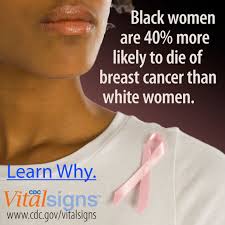Why Black Women Die of Cancer
Share
Explore Our Galleries
Breaking News!
Today's news and culture by Black and other reporters in the Black and mainstream media.
Ways to Support ABHM?
By Harold P. Freeman, New York Times

SINCE the early 1970s, studies have shown that black Americans have a higher death rate from cancer than any other racial or ethnic group. This is especially true when it comes to breast cancer. A study published last week in the journal Cancer Epidemiology found that, in a survey of 41 of America’s largest cities, black women with breast cancer are on average 40 percent more likely to die than their white counterparts.
The principal reason for this disparity is the disconnect between the nation’s discovery and delivery enterprises — between what we know and what we do about sick Americans.(…)
The reasons for black and white differences in breast cancer outcomes are complex. Although the incidence of the disease is higher among white women, black women are more likely to die from it. Young black women tend to develop a particularly aggressive form, which no doubt contributes to the disparity. But for many years, the dominant cause of higher mortality has been late-stage disease at the time of initial treatment, in part as a result of black women being less likely to undergo mammography.
However, this gap has been closed. The Centers for Disease Control and Prevention reports that the rate of mammography is now the same in black and white women. What remains different is what happens after the mammogram: Black women experience significant delays in diagnosis and treatment. According to the C.D.C., even when they have similar insurance coverage, 20 percent of black women with an abnormal mammogram wait more than 60 days for a diagnosis, compared with 12 percent of white women. And 31 percent of black women wait 30 days to begin treatment, compared with 18 percent of white women.
The Institute of Medicine reported in 2003 that black Americans with health insurance similar to that of white Americans are, at times, less likely to be recommended by physicians to receive curative cancer care. I don’t think this is because doctors are racist, but rather that they make assumptions about race that can be harmful. For example, a specialist treating a poor black woman may doubt that she will comply with a complex treatment and recommend a simpler, but noncurative, therapy instead.
The good news is that studies show that black and white women who receive the same breast cancer treatment at the same stage of the disease are equally likely to survive. If we can eliminate barriers to early diagnosis and quality treatment in black women, we can close the racial mortality gap.
Read the full article here.
Some products marketed to Black women can cause cancer.
Read more Breaking News here.









Comments Are Welcome
Note: We moderate submissions in order to create a space for meaningful dialogue, a space where museum visitors – adults and youth –– can exchange informed, thoughtful, and relevant comments that add value to our exhibits.
Racial slurs, personal attacks, obscenity, profanity, and SHOUTING do not meet the above standard. Such comments are posted in the exhibit Hateful Speech. Commercial promotions, impersonations, and incoherent comments likewise fail to meet our goals, so will not be posted. Submissions longer than 120 words will be shortened.
See our full Comments Policy here.